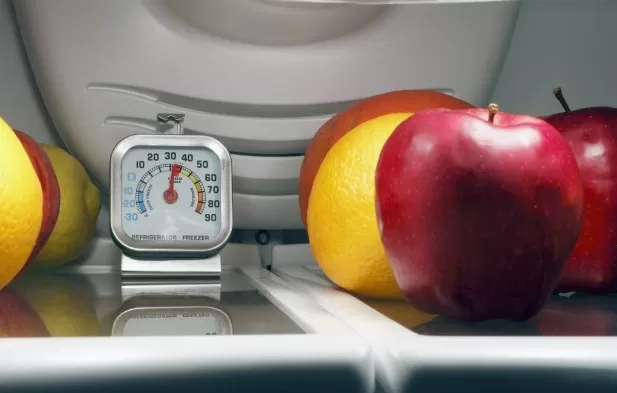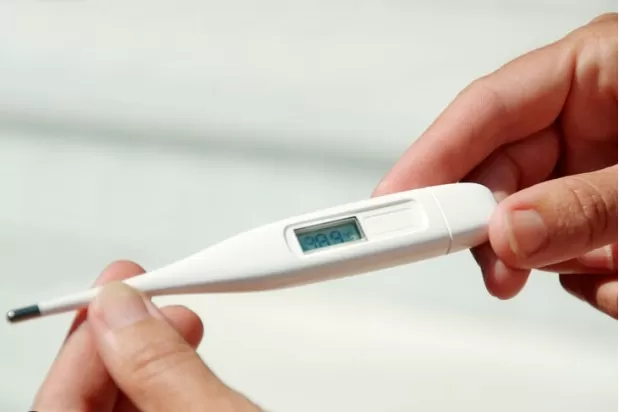Assess your kitchen’s cleanliness with a restaurant health inspection checklist. Discover hidden breeding grounds for bacteria and viruses, like dish towels and doorknobs. Get effective tips for maintaining a hygienic kitchen environment.
Ensure Food Safety: Take the Temperature for Perfectly Cooked Meals

When it comes to cooking, relying on appearance alone is not enough to ensure that your food is cooked properly and safe to eat.
To avoid potential health risks, it’s essential to take a lesson from professional chefs and use a food thermometer to monitor the internal temperature of your meals. By following recommended temperature guidelines, you can enjoy delicious, perfectly cooked dishes without compromising your well-being.
Here’s how you can take the temperature and achieve food safety.
First and foremost, acquire a reliable food thermometer that provides accurate temperature readings.
There are various types available, including instant-read thermometers and digital probe thermometers, which offer quick and precise measurements.
Different types of food have specific minimum internal temperature requirements to ensure they are cooked thoroughly and safe to consume.
Here are some general guidelines:.
Ground meat: Cook ground meat, such as beef or poultry, to an internal temperature of 160 degrees Fahrenheit (71 degrees Celsius) to eliminate any harmful bacteria present.
Fresh beef: For fresh cuts of beef, aim for an internal temperature of 140 degrees Fahrenheit (60 degrees Celsius) to achieve a medium-rare level of doneness.
Adjust the temperature based on your preferred level of doneness.
Fresh pork: Cook fresh pork to an internal temperature of 145 degrees Fahrenheit (63 degrees Celsius) to ensure it is fully cooked and safe to eat.
Poultry: Poultry, including chicken and turkey, should be cooked to an internal temperature of 165 degrees Fahrenheit (74 degrees Celsius) to eliminate any potential pathogens and ensure thorough cooking.
Finned fish: Finned fish can be safely consumed at an internal temperature of 145 degrees Fahrenheit (63 degrees Celsius) when the flesh is firm and opaque.
Seafood: Other types of seafood, such as shrimp or scallops, should be cooked until the flesh becomes firm and opaque, ensuring they are thoroughly cooked.
It’s important to note that these temperature recommendations are general guidelines, and specific recipes or local regulations may provide different guidelines.
Always refer to reputable sources for accurate temperature guidelines based on the type of food you are preparing.
Additionally, once your food has reached the desired internal temperature, it’s crucial to serve and consume it promptly.
Harmful bacteria multiply rapidly in the “danger zone” between 40 and 140 degrees Fahrenheit (4 and 60 degrees Celsius). To prevent bacterial growth and foodborne illnesses, avoid leaving cooked food at room temperature for extended periods.
By taking the temperature of your food, you can ensure its safety and enjoy meals that are both delicious and free from health risks.
Invest in a food thermometer and follow the recommended temperature guidelines for each type of food to achieve cooking perfection.
Remember to clean your food thermometer thoroughly after each use to maintain hygiene and prevent cross-contamination.
So, the next time you cook, don’t rely on visual cues alone.
Embrace the professional approach by taking the temperature of your food, guaranteeing its proper doneness and your well-being.
Maintain Food Safety: Refrigeration Best Practices for Fresh Ingredients
Proper refrigeration is crucial for preserving the freshness and safety of your food.
From the moment you purchase ingredients to storing leftovers, maintaining the right temperature range is essential to prevent bacterial growth and foodborne illnesses. By following these guidelines and investing in a refrigerator thermometer, you can ensure that your food stays at the optimal temperature until it’s ready to be prepared. Here’s how to refrigerate the right way and keep your food safe.
Invest in a refrigerator thermometer: Purchase a reliable refrigerator thermometer to accurately monitor the temperature inside Your Fridge.
This will help you ensure that your food remains within the safe temperature range of 32 to 40 degrees Fahrenheit (0 to 4 degrees Celsius).
Promptly refrigerate perishable items: As soon as you return from the grocery store, promptly place perishable items in the refrigerator.
Even if you’re tired, don’t leave them on the counter for more than two hours. During the summer months, the timeframe reduces to one hour, as warmer temperatures can promote bacterial growth.
Use an insulated bag for long trips: When transporting perishable items, especially meats and frozen foods, consider using an insulated bag or cooler to maintain their cold temperature.
This helps prevent the growth of harmful bacteria during extended journeys.
Set your freezer to 0 degrees Fahrenheit: Ensure that your freezer is set to 0 degrees Fahrenheit (-18 degrees Celsius) or below.
This temperature is optimal for preserving the quality and freshness of frozen food items.
By following these practices, you can safeguard the quality and safety of your food.
Proper refrigeration helps maintain freshness, reduces waste, and minimizes the risk of foodborne illnesses.
Remember to regularly clean and organize your refrigerator to prevent cross-contamination and maintain optimal storage conditions.
Discard any expired or spoiled items promptly.
By prioritizing proper refrigeration and monitoring temperatures, you can enjoy meals prepared with fresh and safe ingredients.
Invest in a refrigerator thermometer and adopt these practices to enhance food safety in your kitchen.
Embrace these refrigeration best practices and create a healthy environment for your food.
Your diligence will result in delicious, safe meals that you can enjoy with peace of mind.
Practice Safe Hygiene: Avoid Hand Contact with Ice

Maintaining proper hygiene while handling food and drinks is crucial to prevent the spread of bacteria and ensure the safety of consumers.
When it comes to ice, it’s important to avoid direct hand contact, as hands can harbor germs that can contaminate both the ice and the beverages. By adopting safer alternatives and investing in suitable equipment, you can ensure a hygienic ice-handling process.
Here’s why keeping your hands out of the ice is essential and how to practice safer methods.
Risk of bacterial contamination: Hands can be breeding grounds for bacteria, even if you believe them to be clean.
Touching ice cubes directly with your hands increases the risk of introducing harmful pathogens, potentially leading to foodborne illnesses.
Contamination of ice supply: When hands come into contact with ice cubes, there’s a chance of contaminating not only the ice in the drink but also the rest of the ice in the bucket or container.
This contamination can easily spread to other beverages, compromising their safety and quality.
Safer alternatives: Instead of using bare hands, opt for safer alternatives when handling ice.
Consider using a dedicated ice scooper or tongs to transfer ice cubes from the container to the drink. These tools minimize direct contact and reduce the risk of contamination.
Automatic ice dispensers: Investing in an ice maker with an automatic dispenser is an excellent long-term solution.
These machines dispense ice directly into the glass, eliminating the need for manual handling and reducing the risk of contamination. Automatic dispensers also offer convenience and hygiene benefits in both personal and commercial settings.
By adopting these practices, you can maintain a hygienic ice-handling process and protect the health of those consuming your drinks.
Remember to regularly clean and sanitize your ice scoops, tongs, or automatic dispenser to prevent cross-contamination.
It’s essential to prioritize safe hygiene practices when handling food and beverages, including ice.
By avoiding hand contact and utilizing safer alternatives, you contribute to a healthier environment and reduce the risk of foodborne illnesses.
So, the next time you’re serving drinks to friends, family, or customers, remember to keep your hands out of the ice.
Embrace the use of dedicated tools or invest in equipment with automatic dispensers to ensure a safe and hygienic experience for everyone.
Maintain Kitchen Hygiene: Clean Your Countertop Appliances for a Safe Kitchen
Keeping your kitchen clean and hygienic is essential to prevent contamination and ensure the safety of your meals.
Countertop appliances play a significant role in meal preparation, but they can also become breeding grounds for bacteria if not properly cleaned. By following simple cleaning practices, you can maintain a safe and healthy kitchen environment. Here’s why it’s important to clean your countertop appliances regularly and how to do it effectively.
Contamination risk: Countertop appliances, including food processors, pasta makers, blenders, can openers, and cutting boards, come into direct contact with food during meal preparation.
If not cleaned thoroughly, these appliances can harbor harmful bacteria, leading to potential foodborne illnesses and cross-contamination.
Regular cleaning and sanitizing: After each use, it’s crucial to scrub and sanitize your countertop appliances to remove food residues and eliminate bacteria.
Use warm Soapy Water and a sponge or brush to thoroughly clean all accessible parts. Pay attention to crevices and blades where food particles can get trapped.
Rinse well to remove any soap residue. Additionally, sanitize surfaces using an appropriate food-safe disinfectant or a mixture of water and vinegar.
Cutting boards: Cutting boards, particularly those used for raw meat, poultry, or fish, require extra attention.
Wash them with hot soapy water after each use, and consider using separate cutting boards for different food types to avoid cross-contamination. Additionally, periodically sanitize cutting boards by applying a diluted bleach solution or hydrogen peroxide.
Maintenance and deep cleaning: Regularly inspect your appliances for any signs of damage or wear.
Follow the manufacturer’s instructions for proper maintenance and cleaning. Some appliances may have removable parts that are dishwasher safe, making cleaning more convenient.
Consider deep cleaning your appliances periodically, ensuring all areas are thoroughly cleaned and sanitized.
By incorporating these practices into your routine, you can maintain a clean and safe kitchen environment.
Remember, proper cleaning of countertop appliances is essential to prevent the buildup of harmful bacteria and ensure the health of your family and guests.
Furthermore, practicing good kitchen hygiene extends beyond countertop appliances.
Wash your hands thoroughly before and after handling food, use separate cutting boards for different food groups, and regularly clean and sanitize other kitchen utensils and surfaces.
By prioritizing cleanliness and hygiene, you can create a safe and healthy cooking environment, reducing the risk of foodborne illnesses and ensuring the enjoyment of delicious, safe meals.
So, after each use, take the time to clean and sanitize your countertop appliances diligently.
Your efforts will contribute to a healthier kitchen and a safer dining experience for you and your loved ones.
Promote Food Safety: Prevent Cross-Contamination by Proper Towel Usage

Maintaining food safety and preventing cross-contamination in your kitchen is crucial for the well-being of your family.
One area that often goes overlooked is the use of kitchen towels. Just as restaurants employ a multitude of towels for different tasks, it’s important to adopt proper towel usage practices at home.
By implementing a few simple steps, you can minimize the risk of cross-contamination and ensure a safe cooking environment. Here’s why it’s important to cut out cross-contamination and how to use towels effectively.
Risk of cross-contamination: Using the same kitchen towel for multiple purposes, such as wiping hands, cleaning surfaces, and mopping up spills, increases the risk of cross-contamination.
Bacteria and germs can easily transfer from one surface to another, potentially contaminating food and leading to foodborne illnesses.
Separate towels for different tasks: To promote food safety, it’s essential to use separate towels for different tasks.
Designate specific towels for drying hands and others for cleaning cooking surfaces, spills, or dishes. This prevents the transfer of bacteria from dirty surfaces to clean hands or food-contact surfaces.
Sanitizing and washing towels: Regularly sanitize kitchen towels to eliminate bacteria.
Soak them in a sanitizing solution of bleach and water according to the manufacturer’s instructions. Alternatively, you can use hot water and laundry detergent to wash towels, following appropriate washing machine settings.
Remember to thoroughly dry towels to prevent the growth of bacteria.
Paper towels for spills: When dealing with spills, especially those involving potentially hazardous substances, it’s best to use disposable paper towels.
Paper towels are convenient and eliminate the risk of cross-contamination, as they are discarded after use. Keep a roll of paper towels handy for quick cleanup and ensure proper disposal.
By adopting these practices, you can significantly reduce the risk of cross-contamination in your kitchen and promote a safer cooking environment.
Additionally, remember to practice good hand hygiene by washing your hands thoroughly with soap and water before and after handling food.
Maintaining food safety extends beyond towel usage.
Clean and sanitize kitchen surfaces regularly, separate cutting boards for different food groups, and handle raw and cooked foods separately to prevent cross-contamination.
By prioritizing proper towel usage and implementing these food safety measures, you can protect the health of your family and ensure the enjoyment of safe and delicious meals.
So, next time you reach for a towel, remember to use separate ones for different tasks and properly sanitize them to prevent cross-contamination.
These simple steps will contribute to a safer kitchen and healthier dining experiences.
*The information is for reference only.